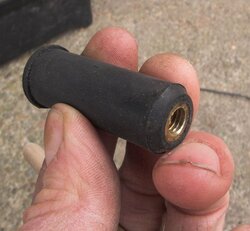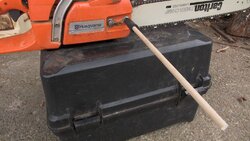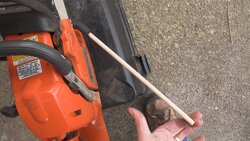I just improvised a jig for measuring firewood lengths when cutting, and it's working well enough that I thought I'd post it here.
A few months ago I was searching for an easy method of cutting firewood to consistent lengths, and found a thread on a different forum where several people were fairly enthusiastic about having a length indicator of some sort attached directly to the saw, sticking out to the right of the bar. Bailey's sells a product called "Quick Stix" that has a reputation for breaking in the first few minutes of use. People suggested a variety of alternatives, the best of which was apparently to weld a spring onto an appropriate nut, and attach a stick to the spring. I can't weld, so I went looking for other solutions. What I found is an obscure piece of hardware called a "well nut," which is a rubber cylinder with a metal nut cast into one end and a hole continuing all the way through. Normally They're meant to be inserted into holes bored into solid materials (e.g. concrete), and a bolt is passed through the hole and threaded into the nut, so that the rubber gets compressed as the bolt is tightened, increasing its diameter so that it grabs the sides of the hole the nut was set in. The studs holding the bar of my Husqvarna saw are M8 metric thread (I get the impression that Stihls use the same thread, but I can't guarantee it). I was unable to find a domestic source for 8mm well nuts, but an eBay seller located in England offers exactly the right thing, and I ordered some.
I added a length of 3/8" dowel, and that's it. I chamfered the end of the dowel before inserting it, so that the corners would be less likely to tear the rubber under stress. The rubber grips the dowel firmly without any adhesive, but can be removed with a little effort.
I've only tested this for a few minutes, but it seems to be a really good solution. The rubber is flexible enough to prevent breakage if you accidentally whack the stick on something, and the large diameter of the well nut makes it easy to grip and install or remove it without tools. It seems to dampen vibration; the stick sits there calmly even when the saw is screaming. The embedded metal nut is brass, not steel, so it spins on and off exceptionally easily.
Hope that helps somebody. BTW, I had to buy 4 well nuts, so I have a couple extras in case anyone is interested...



A few months ago I was searching for an easy method of cutting firewood to consistent lengths, and found a thread on a different forum where several people were fairly enthusiastic about having a length indicator of some sort attached directly to the saw, sticking out to the right of the bar. Bailey's sells a product called "Quick Stix" that has a reputation for breaking in the first few minutes of use. People suggested a variety of alternatives, the best of which was apparently to weld a spring onto an appropriate nut, and attach a stick to the spring. I can't weld, so I went looking for other solutions. What I found is an obscure piece of hardware called a "well nut," which is a rubber cylinder with a metal nut cast into one end and a hole continuing all the way through. Normally They're meant to be inserted into holes bored into solid materials (e.g. concrete), and a bolt is passed through the hole and threaded into the nut, so that the rubber gets compressed as the bolt is tightened, increasing its diameter so that it grabs the sides of the hole the nut was set in. The studs holding the bar of my Husqvarna saw are M8 metric thread (I get the impression that Stihls use the same thread, but I can't guarantee it). I was unable to find a domestic source for 8mm well nuts, but an eBay seller located in England offers exactly the right thing, and I ordered some.
I added a length of 3/8" dowel, and that's it. I chamfered the end of the dowel before inserting it, so that the corners would be less likely to tear the rubber under stress. The rubber grips the dowel firmly without any adhesive, but can be removed with a little effort.
I've only tested this for a few minutes, but it seems to be a really good solution. The rubber is flexible enough to prevent breakage if you accidentally whack the stick on something, and the large diameter of the well nut makes it easy to grip and install or remove it without tools. It seems to dampen vibration; the stick sits there calmly even when the saw is screaming. The embedded metal nut is brass, not steel, so it spins on and off exceptionally easily.
Hope that helps somebody. BTW, I had to buy 4 well nuts, so I have a couple extras in case anyone is interested...



Last edited by a moderator:



 My OCD says that's unacceptable.
My OCD says that's unacceptable. 


